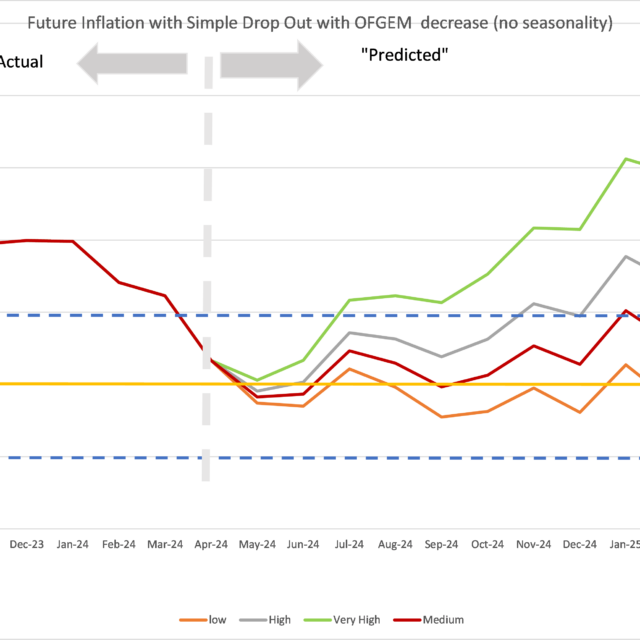Why is the Yield Curve Important?
The UK ‘yield curve’ has figured prominently in the news over the past couple of months as various announcements by the government have led it to move markedly up and down. In today’s Monday Interview, our Deputy Director for Macroeconomic Modelling and Forecasting, Stephen Millard, speaks to Associate Economist Hailey Low about what the yield curve is and why it is important.

What is the yield curve about and how are yield curves relevant to non-investors?
The yield curve plots the interest rates that buyers of government bonds (aka gilts in the UK) demand for differing maturity dates, ranging from one month to 40 years. The ‘spot’ yield curves available on the Bank of England’s website show the interest rates on ‘synthetic’ risk-free government bonds that do not pay any ‘coupon’ rates during their lifetimes but pay back their face value plus interest when they mature. As for the yields of actual bonds that you can buy, these will vary accordingly to the bond’s precise characteristics.
The slope of the yield curve gives an idea of the direction of the economy and where financial markets expect interest rates to go. As lending to governments of countries such as the UK, the US, Germany, and Japan is considered safe, the borrowing rates act like a barometer of investors’ collective expectations of interest rates. There are 3 main types of curve shapes: Normal (upward sloping), Flat, and Inverted (downward sloping). The normal curve denotes a stable functioning economy that is expanding, whereas the inverted yield curve suggests economic slowdown, signalling a potential imminent recession. As for a flat yield curve, it suggests an economy between economic recession and recovery and vice versa.
The inverted yield curve has a profound impact on consumers, especially those financing loans or borrowing using other forms of credit. For homebuyers financing their adjustable-rate mortgages where their payments are based on short-term interest rates, this group will find their payments rising during a yield curve inversion. At this point, fixed-rate loans will be more attractive than an adjustable rates. Also, borrowers on credit cards or other short-term loans will have to apportion a larger share of their income to finance their debt. This reduces their disposable income and has a negative overall effect on the economy.
What determines the shape of the yield curve?
In a climate where the economy is healthy and performing, the curve will be upward sloping, denoting that longer-maturity bonds have a higher yield than shorter-term bonds, which should be the default given longer-term bonds are riskier. However, in times of economic downturn when people expect economic conditions to deteriorate, short-term yields will be higher than the long-term as interest rates will be expected to fall.
This leads us to the question of what economic theory has to say about the shape of the yield curve. They are two complementary economic theories – the pure expectations theory and the liquidity preference theory. The pure expectations theory postulates that long-term rates – specifically the rate of interest on a particular bond of given maturity – are an average of the expected short-term rates over the lifetime of the bond. As for liquidity preference theory, it is more straightforward. Since investors’ money is tied up in bonds with longer maturities, as such they must be compensated for the loss in liquidity. Therefore, the returns offered by long-term bonds must be higher than those by short-term bonds to make them look attractive. This is also known as the liquidity premium.
What’s been happening with the yield curve recently in the UK?
Since the beginning of this year, the curve has been relatively flat as the country emerged out of the pandemic. But it has been rising over this period as high inflation, the Russia-Ukraine War, and supply chain constraints have affected the economy, all at the same time. The steepest inversion occurred on the 30th of September, 7 days after the mini-budget that caused such problems in the economy and financial markets. On that day, the 1-year spot rate was 4% while the 40-year spot rate was slightly over 3%. The yield curve has since returned to normalcy, compared to the outlier case we saw during the mini-budget. As of 18th November, the curve has tipped slightly into inversion with short-term maturity (1-year) gilts yielding higher than long-term (40-year) gilts. The one-year spot rate stood at 3.17% and the 40-year at 2.85%.
Does the flattening yield curve signal a recession for the UK?
On the day of the Autumn Statement, the OBR announced their view that the UK has entered a recession and is forecasted not to emerge from it until 2024. Therefore, the flattening and subsequent inversion of the yield curve, which herald the possibility of a recession, is not surprising. In the US, the yield curve has been a harbinger of economic downturns and predicted almost all recessions since 1955.






















